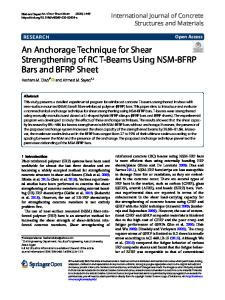Column repair and strengthening using RC jacketing: a brief state-of-the-art review
- PDF / 2,859,238 Bytes
- 11 Pages / 595.276 x 790.866 pts Page_size
- 2 Downloads / 349 Views
STATE-OF-THE-ART PAPER
Column repair and strengthening using RC jacketing: a brief state‑of‑the‑art review Ahed Habib1 · Umut Yildirim1 · Ozgur Eren1 Received: 22 April 2020 / Accepted: 23 June 2020 © Springer Nature Switzerland AG 2020
Abstract Seismic retrofitting and/or the strengthening of RC columns has been a popular area of research for decades. Currently, reinforced concrete jacketing is considered as the most common technique for repairing and strengthening of deficient and/ or damaged RC columns. In general, this technique is a practical solution to recover and improve the load-carrying capacity and stiffness of reinforced concrete columns in earthquake-prone countries. It is a simple method that can be applied to any column cross section for rehabilitating structural elements by encasing the old member in a stiff jacket. The importance of this approach comes from its ability to improve the load-carrying capacity, strength, and stiffness of any column section significantly without the need for experienced labor or complicated installations process. This paper summarizes and compares general conclusions of recent investigations on columns retrofitting using reinforced concrete jacketing. As a part of this study, experimental, analytical, and numerical studies were reviewed and their findings were collected and discussed. Keywords Reinforced concrete jacketing · Concrete column · Strengthening · Repairing
Introduction Rehabilitating old structures is indeed one of the most important activates in the construction industry [48]. Nowadays, reinforced concrete jacketing, Fig. 1, is a common and widely used technique for structural repair and strengthening [32, 33, 51, 52] especially in earthquake-prone countries [16]. In general, it is the method of encasing existed structural elements [66] in a concrete layer (jacket) reinforced with longitudinal and transverse steels [6, 50]. With the ability to be applied to any column’s cross section [5], it is considered as one of the best options to improve axial and bending strengths and stiffness of weak elements significantly [4, 33, 55], in addition to substantially improving the lateral strength of retrofitted frames [59]. The benefits of * Ahed Habib [email protected] Umut Yildirim [email protected] Ozgur Eren [email protected] 1
Department of Civil Engineering, Eastern Mediterranean University, Via Mersin 10, Famagusta, North Cyprus, Turkey
this technique come from the enlargement of the jacketed member’s cross section that provides higher load-carrying capacity and from the confinement pressure induced in the old element by the jacket that improves its behavior significantly [8, 50]. Furthermore, another advantage in this technique is its capability to uniformly distribute the increased lateral resistance throughout the building [57]. As a matter of fact, the literature is enriched with several modern techniques that can provide better behavior and enhanced capabilities if compared to retrofitting using RC jacketing; however, this m
Data Loading...











